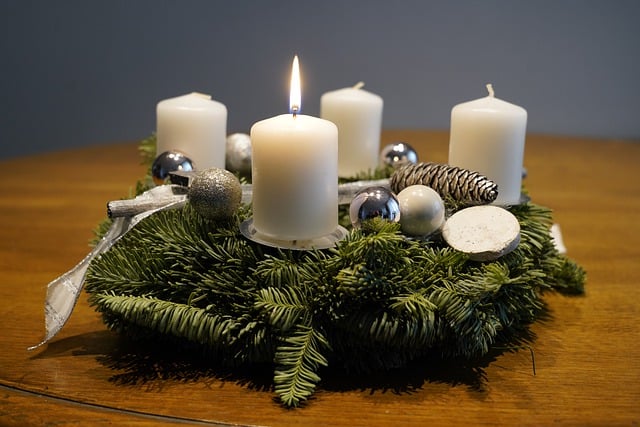Happy New Year!
I am referring to the Christian calendar of course. The church calendar begins with the Advent season. The word advent is derived from the Latin “adventus” which means “coming.” It probably isn’t difficult to guess what we mean this season when we say something is coming. Why shouldn’t it be a new year for Christians? I can think of no better way to start the year than by dwelling on the coming of Christ.
Many churches have an advent wreath in their sanctuary. There isn’t such a thing referenced in the bible, so where did this come from? There is some debate as to how it started but most believe this dates back to the Middle Ages. The wreath as we know it didn’t really get any traction until 1839 (the first advent calendar was mentioned in a picture book in 1851). The story is that a Lutheran minister in Germany created a wreath out of a cart’s wheel. He placed 20 small red candles on the outer ring and four larger white candles inside the ring. He would light the red candles on weekdays and the white candles on Sundays as a way for children to count down the days until Christmas.
Wreaths are circular, symbolizing eternity, or the assertion that there is no beginning or end with God. Today, churches will put either 4 or 5 candles on their wreath. Each candle represents some aspect of the Advent season. The first candle is lit on the first day of the season and is called the candle of hope.
I live on a street with lots of crapemyrtle trees. We had one in our front yard when we bought the house, but we quickly noticed that it was too close to the foundation. We had it cut down but didn’t remove the stump because we were afraid a stump grinder might damage water lines coming into the house. We quickly learned that crapemyrtles are resilient things. A common phrase is “you can’t kill these things.” They just keep coming back. No matter what I do to this stump it wants to spring back to life and grow.
The stump is like Isreal. They thought of themselves as a cut tree waiting to regain life.
Isaiah 11:1-3
A shoot will come up from the stump of Jesse;
from his roots a Branch will bear fruit.
2
The Spirit of the Lord will rest on him—
the Spirit of wisdom and of understanding,
the Spirit of counsel and of might,
the Spirit of the knowledge and fear of the Lord—
3
and he will delight in the fear of the Lord.
Many people think that the hymn “O Come, O Come, Emmanuel” is a Christmas hymn. It isn’t. It is an Advent hymn. It is almost always sung on the first day of the season. Here are the lyrics.
O come, O come, Emmanuel, And ransom captive Israel; That mourns in lonely exile here, Until the Son of God appear.
Rejoice! Rejoice! Emmanuel
Shall come to thee, O Israel.
O come, Thou Rod of Jesse, free
Thine own from Satan’s tyranny;
From depths of hell Thy people save,
And give them victory o’er the grave.
Rejoice! Rejoice! Emmanuel
Shall come to thee, O Israel.
O come, Thou Day-Spring, come and cheer, Our Spirits by Thine Advent here; Disperse the gloomy clouds of night, And death’s dark shadows put to flight.
Rejoice! Rejoice! Emmanuel
Shall come to thee, O Israel.
O come, Thou Key of David, come
And open wide our heavenly home;
Make safe the way that leads on high,
And close the path to misery.
Rejoice! Rejoice! Emmanuel
Shall come to thee, O Israel.
What is the mood of Israel at the time of Jesus’ birth? What does “captive Israel” mean? Israel was (and has been throughout most of its history) captive to some other people. This time it was the Romans. Captivity is not happy, and neither is Advent. This is where hope comes in.
Hope is the desire for something good to happen combined with an anticipation that it might occur. It is possible something good will happen, and we want that to come to pass very much. The opposite of hope may very well be fear. Fear is the desire for something not to happen combined with the same anticipation that it might.
Hope never brings certainty. But hope in things drives us in our lives. Martin Luther said “Everything that is done in the world is done by hope.” Your hopes define your life, don’t they? You work toward something that you hope will happen, or you continue or persist through a hardship because you hope for something better. Hope keeps us going. Hope in Christ sustains us.
Researches in Harvard did a study on hope. They examined its impact on about 13000 people with an average age of 66. They found that people who had more hope in their lives had better physical health and health behaviors, better social support, and few chronic health problems. They had less anxiety and depression and even had a lower risk of cancer.
Hope defines and drives us. Let us let it channel us toward a hope of Christ in our lives this Advent season.
God Bless

